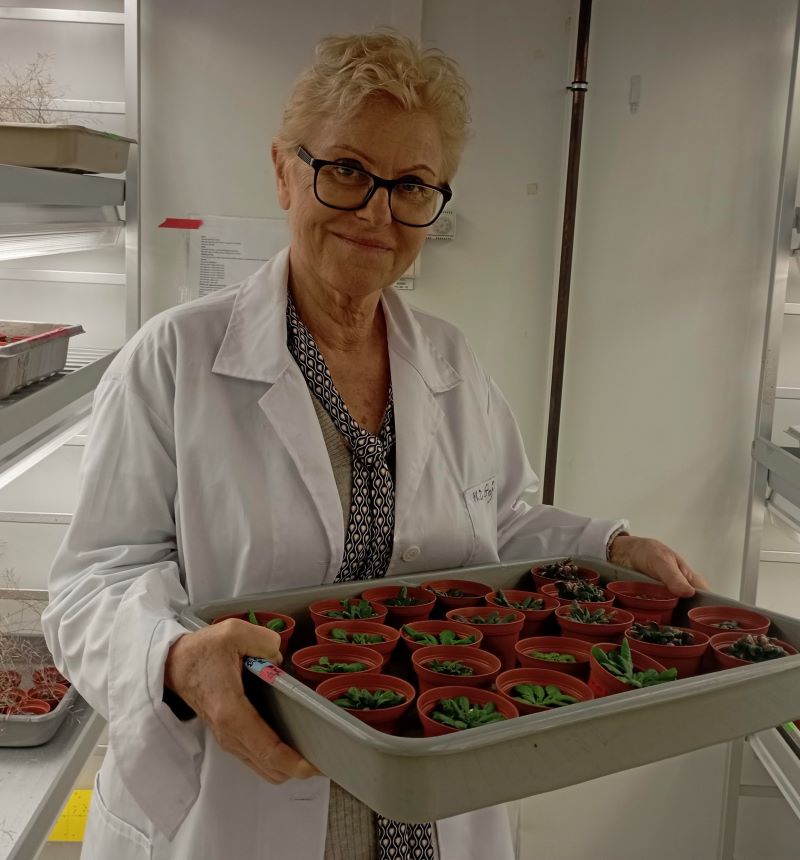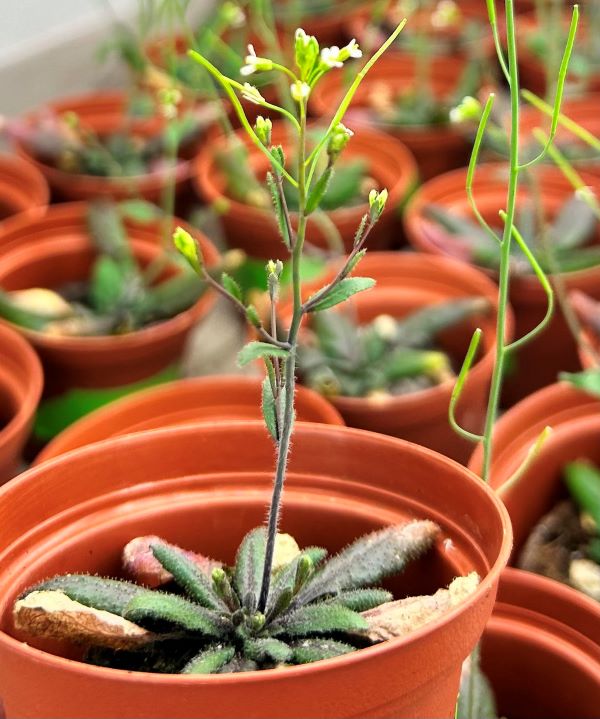| Weronika Cygan-Adamczyk |
When she started her career as a scientist, no one in Poland was working on this small, inconspicuous plant. Only thanks to her promoter, Prof. Mirosław Małuszyński, who in the 1980s brought small seeds from an internship in Belgium and began his adventure with Arabidopsis thaliana – the thale cress, also known as mouse-ear cress.
‘Everyone in Europe is talking about it. ‘Do something with this plant’ recalls Prof. Małgorzata Gaj, geneticist and plant biotechnologist from the Faculty of Natural Sciences of the University of Silesia. She listened to her boss and devoted her scientific career to Arabidopsis for many years to come. Soon, research on it became the centre of interest in genetics and, with the development of molecular biology, salso in plant genomics. Currently, this plant is being researched in several centres in Poland and hundreds around the world.
A priceless weed
This inconspicuous plant growing along roadsides may at first seem a strange choice for scientists. After all, it is not a cultivated plant, but a weed. Related to cabbage, although so unlike, the plant has many features that are extremely useful for a biologist, especially a geneticist. It is relatively small, which means it can be grown in large quantities in a small space. It is easy to care for, self-pollinating and has a short life cycle – after just 6 weeks it can produce numerous offspring, up to several thousand seeds.
‘For a molecular geneticist, the most important qualities of this plant are hidden, of course, in its DNA. A. thaliana was the first higher plant to have its DNA sequenced back in 2000. This was achieved thanks to the unusually small genome of Arabidopsis. Higher plants usually have much larger genomes – for example, cereals contain approximately 2–17 billion base pairs in their DNA (the human genome contains 3 billion of them). Meanwhile, thale cress has only 120 million base pairs’ explains Prof. Małgorzata Gaj.
This unique feature of the Arabidopsis genome greatly facilitates the identification and analysis of plant gene functions. Hence, this inconspicuous weed has become a model species for studying genes in dicotyledonous plants.
The plant phenomenon
Using Arabidopsis, the researcher has been identifying and analysing the functions of genes enabling plant regeneration under in vitro conditions for years. These techniques allow the creation of a faithful genetic copy of the organism. Prof. Małgorzata Gaj emphasises that the concept of cloning has become very popular in the context of animals and raises a lot of emotions and controversy in relation to humans. Less attention is paid to cloning plants, although this technique has been used for years in plant biotechnology, among others, for the production of ornamental plants. It is highly probable that all the carnations, orchids or chrysanthemums available in flower shops were created by cloning.
We know many different ways of reproducing plants in nature. In addition to generative (through seeds) reproduction, vegetative reproduction (development of a plant from a fragment of the parent specimen) is also possible. In the 1950s, it was proven that using in vitro culture methods we can recreate a plant from small tissue fragments (so-called explants), even from isolated cells.
Regenerated plants can be created from embryos produced in in vitro culture. Unlike in nature, these embryos are formed from body cells other than gametes – the so-called somatic cells that build plant tissues in the shoot and root. Unlike zygotic embryos found in seeds, they arise from e.g. leaf cells. They create clones of the parent plant. The ability to undergo somatic embryogenesis is a phenomenon unique to plants.
‘The scientists are curious about the molecular mechanism of this process. Geneticists ask, for example, which genes are responsible for the fact that somatic cells that previously performed various functions in the plant, under specific in vitro culture conditions, are able to change their previous identity and transform into embryogenic cells’ explains Prof. Małgorzata Gaj.
Induction of the somatic embryogenesis process requires specific in vitro culture conditions, which vary depending on the plant species, its genotype, and even the type and age of the induced tissue. Prof. Małgorzata Gaj recalls the figure of the Austrian botanist Gottlieb Haberlandt, considered the father of the idea of plant cloning, who was already looking for ways to initiate regeneration in in vitro cultures at the beginning of the 20th century. He experimented with various media, wanting to stimulate the growth of cut plant fragments. Today we know that, apart from the obvious ingredients necessary for plants to develop, such as water and mineral salts, extremely improtant role is played by phytohormones – plant hormones. The first of them, auxin, was discovered in 1937, and the next ones, cytokinins, in the 1950s. Since then, these two types of phytohormones have been widely used in nutrient media. By selecting the concentrations of phytohormones and other culture conditions, we can control the development of plant cells.
Although in theory cloning plants seems to be a simple procedure for many species, in practice it is demanding and causes frustration of young biotechnologists. It happens that colonies of fungi or bacteria grow on the medium instead of regenerated plants, which are the result of infection of the culture with microorganisms. Effective sterilisation of plant material, nutrient media and tools used are extremely important. Acclimatisation to growing conditions outside the laboratory is also important.
It is is a time-consuming process during which we transfer the regenerants from the nutrient solution to the soil and gradually adapt them to new living conditions, including light and humidity, so that they are able to develop into full-fledged plants.
This method of plant production – through micropropagation – makes it possible to obtain a huge number of genetically identical daughter plants produced from a small amount of mother plant tissue in a relatively short time. Thanks to this process, obtaining various flowers, but also trees and shrubs has become more common, effective and profitable. The high health quality of plants produced in this way is also important. It is possible to obtain healthy, virus-free specimens even from material taken from a virus-infected donor plant. However, Prof. Małgorzata Gaj emphasises that the condition is their regeneration from a microscopic fragment of the apical meristem.
Prof. Małgorzata Gaj | photo: Katarzyna Nowak
Green baby boom
Beyond producing plants for market, there are other reasons for biotechnologists’ interest in regenerating plants in in vitro culture. ‘Micropropagation of cereals for production purposes would make no economic sense. However, in cereals, effective in vitro culture techniques are very important because they are a component of the methods used to genetically modify traits in crop plants’ explains the researcher. Such a feature may be faster growth or greater resistance to drought, cold or pests of grain or other crops. This is where Arabidopsis comes to the rescue.
‘It is in this plant that we discover genes that can improve the efficiency of plant regeneration in in vitro culture. One of the first of these was called the baby boom (BBM). Excessive BBM activity leads to the formation of numerous somatic embryos in in vitro culture, which develop into daughter plants. By inducing the effect of overexpression of the BBM gene, the regenerative capacity in in vitro culture was improved in several crop plants, including peppers, cocoa and several cereals (barley, rice, corn)’ explains the geneticist.
Already 20 years ago, during her stay at the University of California in Berkeley (USA) as part of a Fulbright scholarship, Prof. Małgorzata Gaj discovered that in Arabidopsis an effect similar to BBM is caused by the LEC2 gene. It encodes a protein called a transcription factor that regulates the expression of other genes. The Genetics and Biotechnology of Somatic Plant Cells group, which she heads at the university, is looking for Arabidopsis’ genes that influence the ability to regenerate other plants important for use in in vitro culture. The team’s research interests focus mainly on genes related to auxin and epigenetic processes.
The biotechnologist emphasises that although the area of research she deals with is not often publicised in the media and does not attract wide public interest, it is of practical importance, contributing, among other things, to further progress in plant breeding. It is through advancing basic research and analysis of model organisms like Arabidopsis that we discover the secrets of nature that give us new ways to improve our lives.
The article ‘Small plant, great possibilities’ was published in the March issue of University of Silesia Magazine 7 (317).
in vitro culture of Arabidopsis tissues | photo: Anna Wójcik







